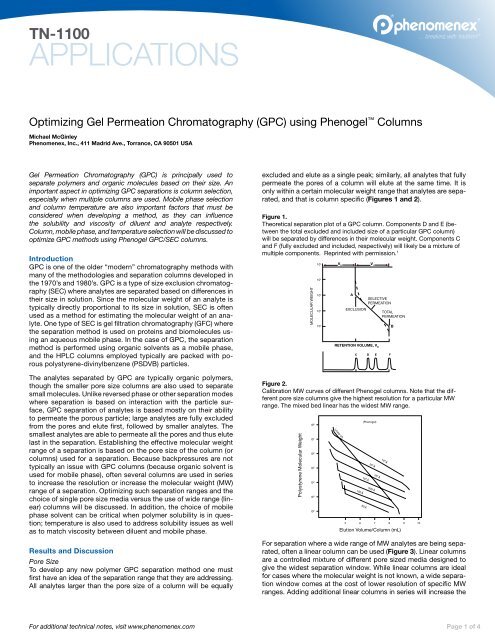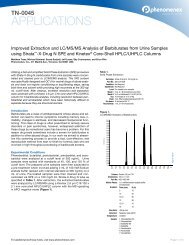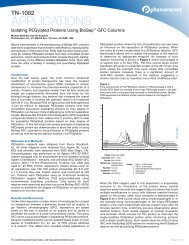(GPC) using Phenogel™ Columns - NET
(GPC) using Phenogel™ Columns - NET
(GPC) using Phenogel™ Columns - NET
You also want an ePaper? Increase the reach of your titles
YUMPU automatically turns print PDFs into web optimized ePapers that Google loves.
TN-1100<br />
APPLICATIONS<br />
Optimizing Gel Permeation Chromatography (<strong>GPC</strong>) <strong>using</strong> Phenogel <strong>Columns</strong><br />
Michael McGinley<br />
Phenomenex, Inc., 411 Madrid Ave., Torrance, CA 90501 USA<br />
Gel Permeation Chromatography (<strong>GPC</strong>) is principally used to<br />
separate polymers and organic molecules based on their size. An<br />
important aspect in optimizing <strong>GPC</strong> separations is column selection,<br />
especially when multiple columns are used. Mobile phase selection<br />
and column temperature are also important factors that must be<br />
considered when developing a method, as they can influence<br />
the solubility and viscosity of diluent and analyte respectively.<br />
Column, mobile phase, and temperature selection will be discussed to<br />
optimize <strong>GPC</strong> methods <strong>using</strong> Phenogel <strong>GPC</strong>/SEC columns.<br />
Introduction<br />
<strong>GPC</strong> is one of the older “modern” chromatography methods with<br />
many of the methodologies and separation columns developed in<br />
the 1970’s and 1980’s. <strong>GPC</strong> is a type of size exclusion chromatography<br />
(SEC) where analytes are separated based on differences in<br />
their size in solution. Since the molecular weight of an analyte is<br />
typically directly proportional to its size in solution, SEC is often<br />
used as a method for estimating the molecular weight of an analyte.<br />
One type of SEC is gel filtration chromatography (GFC) where<br />
the separation method is used on proteins and biomolecules <strong>using</strong><br />
an aqueous mobile phase. In the case of <strong>GPC</strong>, the separation<br />
method is performed <strong>using</strong> organic solvents as a mobile phase,<br />
and the HPLC columns employed typically are packed with porous<br />
polystyrene-divinylbenzene (PSDVB) particles.<br />
The analytes separated by <strong>GPC</strong> are typically organic polymers,<br />
though the smaller pore size columns are also used to separate<br />
small molecules. Unlike reversed phase or other separation modes<br />
where separation is based on interaction with the particle surface,<br />
<strong>GPC</strong> separation of analytes is based mostly on their ability<br />
to permeate the porous particle; large analytes are fully excluded<br />
from the pores and elute first, followed by smaller analytes. The<br />
smallest analytes are able to permeate all the pores and thus elute<br />
last in the separation. Establishing the effective molecular weight<br />
range of a separation is based on the pore size of the column (or<br />
columns) used for a separation. Because backpressures are not<br />
typically an issue with <strong>GPC</strong> columns (because organic solvent is<br />
used for mobile phase), often several columns are used in series<br />
to increase the resolution or increase the molecular weight (MW)<br />
range of a separation. Optimizing such separation ranges and the<br />
choice of single pore size media versus the use of wide range (linear)<br />
columns will be discussed. In addition, the choice of mobile<br />
phase solvent can be critical when polymer solubility is in question;<br />
temperature is also used to address solubility issues as well<br />
as to match viscosity between diluent and mobile phase.<br />
Results and Discussion<br />
Pore Size<br />
To develop any new polymer <strong>GPC</strong> separation method one must<br />
first have an idea of the separation range that they are addressing.<br />
All analytes larger than the pore size of a column will be equally<br />
excluded and elute as a single peak; similarly, all analytes that fully<br />
permeate the pores of a column will elute at the same time. It is<br />
only within a certain molecular weight range that analytes are separated,<br />
and that is column specific (Figures 1 and 2).<br />
Figure 1.<br />
Theoretical separation plot of a <strong>GPC</strong> column. Components D and E (between<br />
the total excluded and included size of a particular <strong>GPC</strong> column)<br />
will be separated by differences in their molecular weight. Components C<br />
and F (fully excluded and included, respectively) will likely be a mixture of<br />
multiple components. Reprinted with permission. 1<br />
For separation where a wide range of MW analytes are being separated,<br />
often a linear column can be used (Figure 3). Linear columns<br />
are a controlled mixture of different pore sized media designed to<br />
give the widest separation window. While linear columns are ideal<br />
for cases where the molecular weight is not known, a wide separation<br />
window comes at the cost of lower resolution of specific MW<br />
ranges. Adding additional linear columns in series will increase the<br />
For additional technical notes, visit www.phenomenex.com Page 1 of 4<br />
MOLECULAR WEIGHT<br />
10 3<br />
10 4<br />
10 5<br />
10 4<br />
10 3<br />
V O V I<br />
A<br />
EXCLUSION<br />
RETENTION VOLUME, V R<br />
SELECTIVE<br />
PERMEATION<br />
C D E F<br />
TOTAL<br />
PERMEATION<br />
Figure 2.<br />
Calibration MW curves of different Phenogel columns. Note that the different<br />
pore size columns give the highest resolution for a particular MW<br />
range. The mixed bed linear has the widest MW range.<br />
Polystyrene Molecular Weight<br />
Elution Volume/Column (mL)<br />
B
TN-1100<br />
APPLICATIONS<br />
resolution of the entire MW separation and not specific MW ranges.<br />
For improved resolution of a particular MW range, a specific pore<br />
size column or a combination of adjacent pore columns should be<br />
used.<br />
Figure 3.<br />
Polystyrene standards separated on a Phenogel Linear (2) column (300 x<br />
7.8 mm). Note that the Phenogel Linear column can separate very wide<br />
MW ranges of polymers. For higher resolution of a particular MW range,<br />
individual pore size columns (or columns placed in series) should be used.<br />
Column: Phenogel 5 μm Linear(2)<br />
Dimensions: 300 x 7.8 mm<br />
Part No.: 00H-3259-K0<br />
Mobile Phase: THF<br />
Flow Rate: 1.0 mL/min<br />
Detection: Rl<br />
Injection Volume: 50 µL<br />
Temperature: 35 °C<br />
Sample: Polystyrene standards injected<br />
1. 2,860,000 MW<br />
2. 277,000 MW<br />
3. 9,350 MW<br />
Using multiple columns of the same pore size or adjacent pore sizes<br />
is the better solution for situations where increased resolution of<br />
a particular MW range is needed. If a narrow MW range is needed,<br />
multiple columns (or a longer column) of the same pore size can be<br />
used to increase resolution between analytes. In most cases combining<br />
adjacent pore sized columns is the best solution where the<br />
MW separation range is slightly widened while increasing the separation<br />
window. An example of this is shown in Figure 4 where longchain<br />
hydrocarbons are well resolved by combining a 50 Å, 100 Å,<br />
and 500 Å in series. The typical convention for combining different<br />
pore-sized columns has one go from smaller pore to larger pore<br />
column in series, however in some cases the opposite orientation<br />
may give better results so it is often best to test both directions.<br />
Page 2 of 4<br />
App ID 5444<br />
Figure 4.<br />
Long-chain hydrocarbons separated on a 50 Å, 100 Å, and 500 Å Phenogel<br />
column attached in series. Note the excellent resolution across the<br />
narrow MW range that the series of fixed-pore columns provide for closely<br />
related hydrocarbons.<br />
Column: Phenogel 5 μm 50 Å, 100 Å, 500 Å<br />
Dimensions: 300 x 7.8 mm<br />
Part No.: 00H-0441-K0 (50 Å)<br />
00H-0442-K0 (100 Å)<br />
00H-0443-K0 (500 Å)<br />
Mobile Phase: THF<br />
Flow Rate: 1.0 mL/min<br />
Detection: Differential Refractometer<br />
Injection Volume: 100 µL 0.25 % w/v<br />
Temperature: Ambient<br />
Sample: 1. C40 562 MW<br />
2. C32 450 MW<br />
3. C24 338 MW<br />
4. C20 282 MW<br />
5. C16 226 MW<br />
6. C13 184 MW<br />
Solvent and Temperature<br />
While column selection is probably the more important aspect of<br />
method development for <strong>GPC</strong> methods, mobile phase and column<br />
temperature can have significant roles in obtaining the maximum<br />
resolution of a separation. Because many polymers demonstrate<br />
poor solubility in certain solvents, one must first verify analyte solubility<br />
in the chosen column mobile phase. Often THF is substituted<br />
with DMF or HFIP for certain polymers with limited solubility even<br />
though MW standards often deliver better performance <strong>using</strong> THF<br />
as a mobile phase. Figure 5 is an example where a different solvent<br />
is used. Nylon is not soluble in a majority of organic solvents; HFIP<br />
is used as a mobile phase because it can solubilize nylon. A slightly<br />
elevated temperature (30 °C) is used to better match viscosity differences<br />
between the diluent and mobile phase. Because column<br />
interactions are minimized in <strong>GPC</strong>, any differences in viscosity between<br />
the diluent and mobile phase can lead to band broadening<br />
and peak distortion. Elevating the column temperature can help<br />
minimize such distortions; however, one must be careful to take<br />
into account the boiling point of the solvent to avoid outgassing;<br />
staying 50 °C below the boiling point of a solvent is a good idea.<br />
Finally, the use of a salt that is soluble in organic solvent can help<br />
minimize secondary interactions between the column and analytes;<br />
lithium bromide is sometimes used to minimize such interactions<br />
as well as break up aggregates.<br />
App ID 5432<br />
For additional technical notes, visit www.phenomenex.com
TN-1100<br />
APPLICATIONS<br />
Figure 5.<br />
Separation of nylon on a Phenogel Linear column. HFIP is used as a mobile<br />
phase. Different mobile phase solvents must sometimes be used to<br />
properly solubilize an analyte. Temperature should also be used to minimize<br />
differences between diluent and mobile phase viscosity.<br />
Column: Phenogel 10 µm Linear(2) x 2<br />
Dimensions: 300 x 7.8 mm<br />
Part No.: 00H-3260-K0<br />
Mobile Phase.: HFIP (0.01 M NATFAT)<br />
Flow Rate: 1.8 mL/min<br />
Detection: Differential Refractometer<br />
Injection Volume: 100 µL 0.25 % w/v<br />
Temperature: 30 °C<br />
Sample: Nylon 6<br />
14,500 MW<br />
Conclusion<br />
<strong>GPC</strong> is a separation method that has unique rules for optimizing a<br />
separation. Column type (mixed bed or fixed-pore) as well as pore<br />
size is the primary method for optimizing a separation method.<br />
For wide MW range separations “mixed bed” Phenogel Linear<br />
columns should be used. For more defined MW ranges one can<br />
use a combination of fixed-pore columns to optimize the resolution<br />
for a particular analyte mixture. While the pore size of the<br />
column plays the biggest role in the selectivity of a <strong>GPC</strong> method,<br />
the solvent used can also be important. Using a mobile phase<br />
that analytes are soluble in is key. Finally, column temperature is<br />
used to minimize viscosity differences between the mobile phase<br />
and diluent, which can perturb peaks shapes and result in lower<br />
resolution.<br />
References<br />
1. L.R. Snyder and J.J. Kirkland, Introduction to Modern Liquid Chromatography,<br />
2nd Ed., Wiley-Interscience, New York, 1979<br />
For additional technical notes, visit www.phenomenex.com<br />
App ID 5445<br />
Page 3 of 4
TN-1100<br />
APPLICATIONS<br />
Australia<br />
t: 02-9428-6444<br />
f: 02-9428-6445<br />
auinfo@phenomenex.com<br />
Austria<br />
t: 01-319-1301<br />
f: 01-319-1300<br />
anfrage@phenomenex.com<br />
Belgium<br />
t: +31 (0)30-2418700<br />
f: +31 (0)30-2383749<br />
beinfo@phenomenex.com<br />
Canada<br />
t: (800) 543-3681<br />
f: (310) 328-7768<br />
info@phenomenex.com<br />
Denmark<br />
t: 4824 8048<br />
f: 4810 6265<br />
nordicinfo@phenomenex.com<br />
Finland<br />
t: (09)4789 0063<br />
f: +45 4810 6265<br />
nordicinfo@phenomenex.com<br />
France<br />
t: 01 30 09 21 10<br />
f: 01 30 09 21 11<br />
franceinfo@phenomenex.com<br />
Germany<br />
t: 06021-58830-0<br />
f: 06021-58830-11<br />
anfrage@phenomenex.com<br />
Ireland<br />
t: 01 247 5405<br />
f: +44 1625-501796<br />
eireinfo@phenomenex.com<br />
Italy<br />
t: 051 6327511<br />
f: 051 6327555<br />
italiainfo@phenomenex.com<br />
Luxembourg<br />
t: +31 (0)30-2418700<br />
f: +31 (0)30-2383749<br />
nlinfo@phenomenex.com<br />
Mexico<br />
t: 001-800-844-5226<br />
f: 001-310-328-7768<br />
tecnicomx@phenomenex.com<br />
The Netherlands<br />
t: 030-2418700<br />
f: 030-2383749<br />
nlinfo@phenomenex.com<br />
New Zealand<br />
t: 09-4780951<br />
f: 09-4780952<br />
nzinfo@phenomenex.com<br />
Norway<br />
t: 810 02 005<br />
f: +45 4810 6265<br />
nordicinfo@phenomenex.com<br />
Puerto Rico<br />
t: (800) 541-HPLC<br />
f: (310) 328-7768<br />
info@phenomenex.com<br />
United Kingdom<br />
t: 01625-501367<br />
f: 01625-501796<br />
ukinfo@phenomenex.com<br />
All other countries:<br />
Corporate Office USA<br />
t: (310) 212-0555<br />
f: (310) 328-7768<br />
info@phenomenex.com<br />
www.phenomenex.com<br />
Phenomenex products are available worldwide. For the distributor in your country,<br />
contact Phenomenex USA, International Department at international@phenomenex.com<br />
Page 4 of 4<br />
Ordering Information<br />
5 μm <strong>Columns</strong> (mm) GGuards s<br />
300 x 7.8 600 x 7.8 300 x 21.2 50 x 7.8<br />
Pore Size MW Range<br />
50 Å 100-3 K 00H-0441-K0 — — 03B-2088-K0<br />
100 Å 500-6 K 00H-0442-K0 00K-0442-K0 — 03B-2088-K0<br />
500 Å 1 K-15 K 00H-0443-K0 — — 03B-2088-K0<br />
10 3 Å 1 K-75 K 00H-0444-K0 — — 03B-2088-K0<br />
10 4 Å 5 K-500 K 00H-0445-K0 00K-0445-K0 00H-0445-P0 03B-2088-K0<br />
10 5 Å 10 K-1,000 K 00H-0446-K0 00K-0446-K0 00H-0446-P0 03B-2088-K0<br />
10 6 Å 60 K-10,000 K 00H-0447-K0 — 00H-0447-P0 03B-2088-K0<br />
300 x 7.8 600 x 7.8 — 50 x 7.8<br />
Mixed Beds<br />
Linear(2) 100-10,000 K 00H-3259-K0 00K-3259-K0 — 03B-2088-K0<br />
5 μm Narrow Bore (NB) <strong>Columns</strong> (mm) Guards Guards<br />
300 x 4.6 30 x 4.6<br />
Pore Size MW Range<br />
50 Å 100-3 K 00H-0441-E0 03A-2088-E0<br />
100 Å 500-6 K 00H-0442-E0 03A-2088-E0<br />
500 Å 1K-15 K 00H-0443-E0 03A-2088-E0<br />
10 3 Å 1K-75 K 00H-0444-E0 03A-2088-E0<br />
10 4 Å 5K-500 K 00H-0445-E0 03A-2088-E0<br />
10 μm <strong>Columns</strong> (mm) Guard Guards<br />
300 x 7.8 600 x 7.8 300 x 21.2 600 x 21.2 50 x 7.8<br />
Pore Size MW Range<br />
50 Å 100-3 K 00H-0641-K0 00K-0641-K0 00H-0641-P0 00K-0641-P0 03B-2090-K0<br />
100 Å 500-6 K 00H-0642-K0 00K-0642-K0 00H-0642-P0 00K-0642-P0 03B-2090-K0<br />
500 Å 1 K-15 K 00H-0643-K0 00K-0643-K0 — 00K-0643-P0 03B-2090-K0<br />
10 3 Å 1 K-75 K 00H-0644-K0 00K-0644-K0 00H-0644-P0 00K-0644-P0 03B-2090-K0<br />
10 4 Å 5 K-500 K 00H-0645-K0 00K-0645-K0 00H-0645-P0 00K-0645-P0 03B-2090-K0<br />
10 5 Å 10 K-1,000 K 00H-0646-K0 00K-0646-K0 00H-0646-P0 00K-0646-P0 03B-2090-K0<br />
10 6 Å 60 K-10,000 K 00H-0647-K0 00K-0647-K0 00H-0647-P0 00K-0647-P0 03B-2090-K0<br />
300 x 7.8 600 x 7.8 300 x 21.2 — 50 x 7.8<br />
Mixed Beds<br />
Linear(2) 100-10,000 K 00H-3260-K0 00K-3260-K0 00H-3260-P0 — 03B-2090-K0<br />
Other Shipping Solvents:<br />
Methanol, Methylene Chloride, Cyclohexane, Ethyl<br />
Acetate, NMP, DMAC, DMF<br />
Size (mm)<br />
30 x 4.6<br />
50 x 4.6<br />
300 x 4.6<br />
300 x 7.8<br />
600 x 7.8<br />
300 x 21.2<br />
600 x 21.2<br />
NOTE: Phenogel columns are routinely shipped<br />
in THF. <strong>Columns</strong> can be shipped in Toluene and<br />
Chloroform upon request at no additional charge.<br />
If Phenomenex products in this technical note do not provide at least an equivalent<br />
separation as compared to other products of the same phase and dimensions,<br />
return the product with comparative data within 45 days for a FULL REFUND.<br />
Terms and Conditions<br />
Subject to Phenomenex Standard Terms and Conditions, which may be viewed<br />
at www.phenomenex.com/TermsAndConditions.<br />
Trademarks<br />
Phenomenex is a registered trademark of Phenomenex, Inc. Phenogel is a trademark of<br />
Phenomenex, Inc.<br />
© 2011 Phenomenex, Inc. All rights reserved.<br />
TN84280111_L





